Choosing the wrong wipes can ruin surfaces or harm your brand—get it right the first time.
Household wipes1 are made for light-duty cleaning2 with mild ingredients, while industrial wipes3 handle grease, oils, and chemical residues with stronger materials and actives.

Whether you’re a facility manager or a brand owner, the type of wipe you use matters more than you think. Let me walk you through what sets them apart—and why it should guide your buying decisions.
What Are Household Cleaning Wipes?
A clean kitchen4 isn’t just about appearance—it’s also about safety and hygiene5.
Household wipes are typically soft, lightly fragranced, and designed for quick, daily cleaning of surfaces like countertops, baby items, and bathroom tiles.
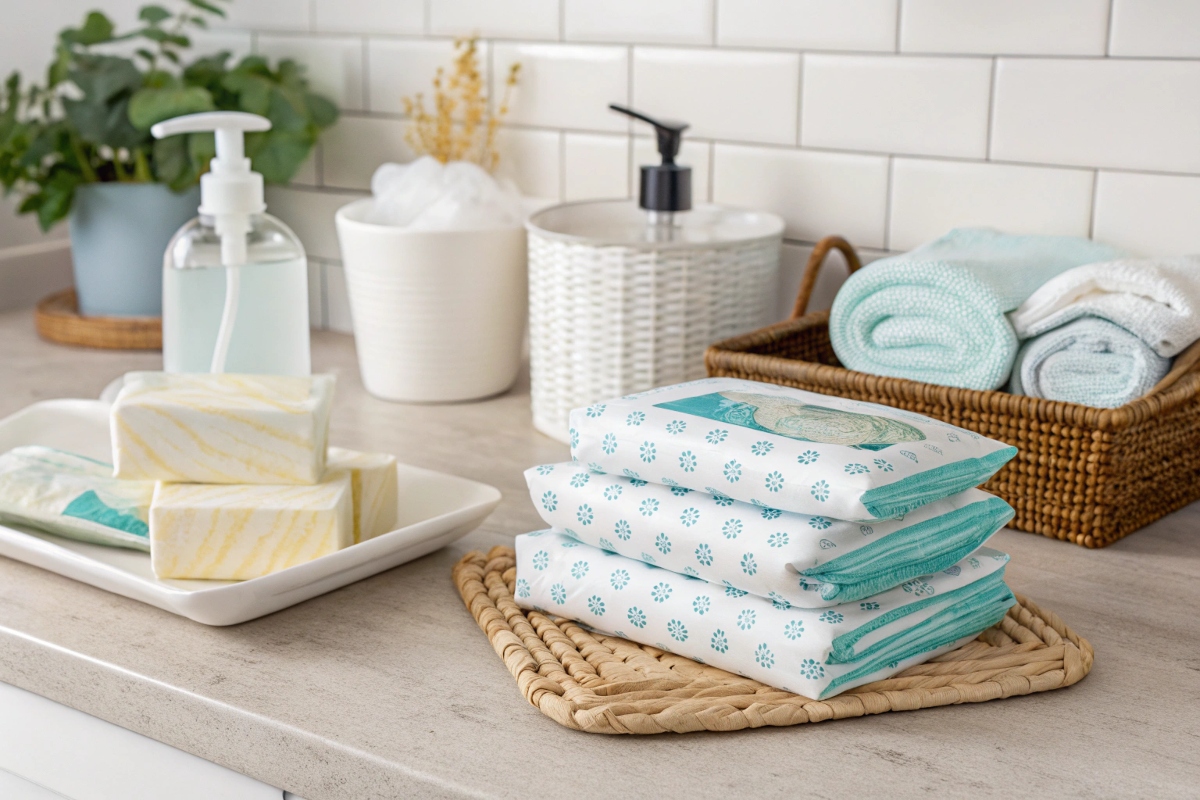
Household cleaning wipes are made for daily consumer use. Most of them are made from soft spunlace or airlaid nonwoven fabric6. They are pre-moistened with gentle surfactants and sometimes include plant-based actives or baby-safe ingredients. Common use scenarios include wiping kitchen counters, baby changing areas, or bathroom surfaces.
Some even come with fragrances like lemon or lavender to appeal to household users. Packaging is usually lightweight and resealable to prevent drying out. Here’s a quick table comparing common household wipe types:
| Application Area | Material | Typical Additives | Packaging |
|---|---|---|---|
| Kitchen | Spunlace | Lemon scent, mild alcohol | Resealable pouch |
| Baby care | Airlaid pulp | Aloe vera, fragrance-free | Flip-top plastic box |
| Floor cleaning | Needle-punched | Detergents | Refill packs |
These wipes are not made to remove grease from machinery or to disinfect high-risk environments. They are optimized for convenience and mild effectiveness.
What Are Industrial Cleaning Wipes?
Heavy-duty environments demand more than household wipes can handle.
Industrial wipes are engineered to handle grease, oil, chemicals, and bio-contaminants in factories, workshops, and hospitals.
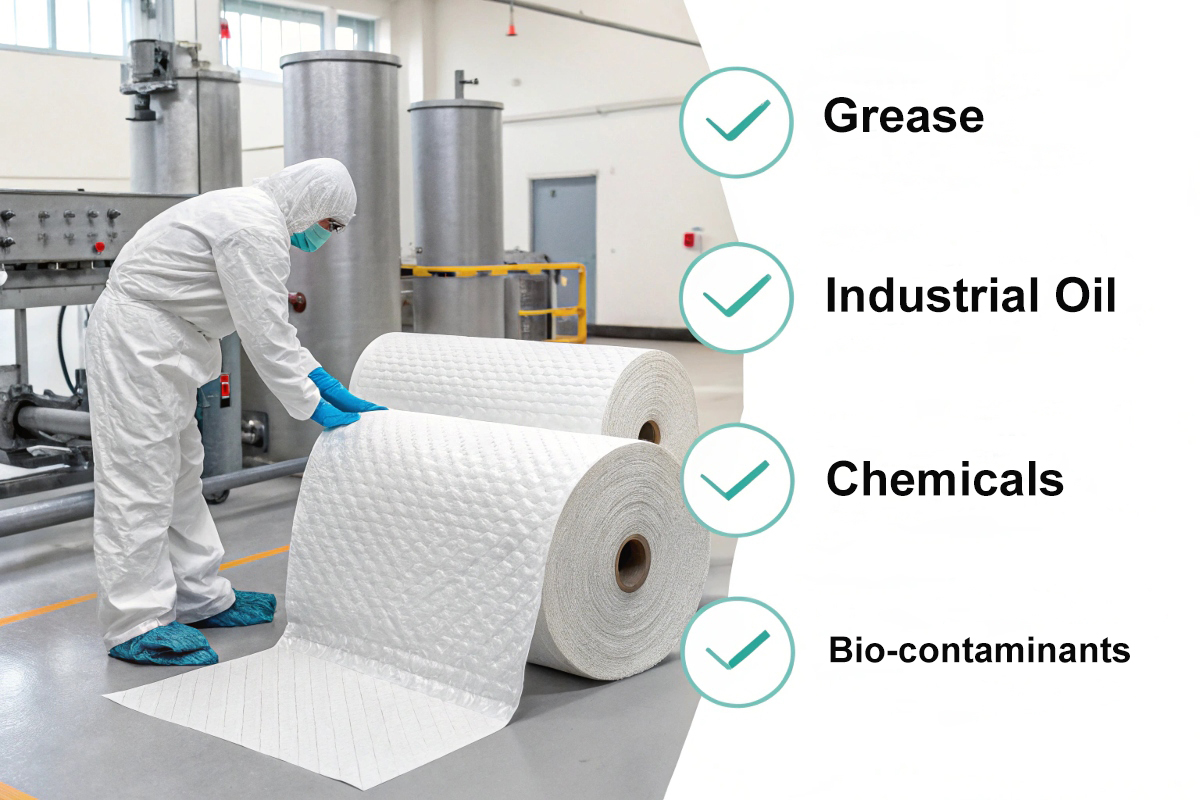
Industrial wipes are designed for specific and harsh environments. In automotive and mechanical workshops, they remove grease and motor oil. In healthcare, they may include biocides for disinfection. In food processing, they must comply with food-contact safety standards.
The material must withstand friction and be compatible with aggressive solvents. Meltblown and spunlace are most common. Many industrial wipes are solvent-resistant and alcohol-infused. The packaging is more durable—often pails, buckets, or roll-fed dispensers.
| Industry | Material | Additives | Packaging |
|---|---|---|---|
| Automotive | Meltblown7 | Degreasers, solvents | Canister or pail |
| Food processing | Spunlace8 | Food-safe disinfectants | Center-pull rolls |
| Healthcare | Composite | Quats, biocides9, 70% alcohol | Sealed sachets |
They also need to meet stricter regulations like EPA, FDA, or REACH depending on their region and use.
How Do Their Materials Compare?
Material choice affects wipe performance more than most realize.
Spunlace is common in both segments, but meltblown and needle-punched wipes dominate industrial applications for their durability and absorption.
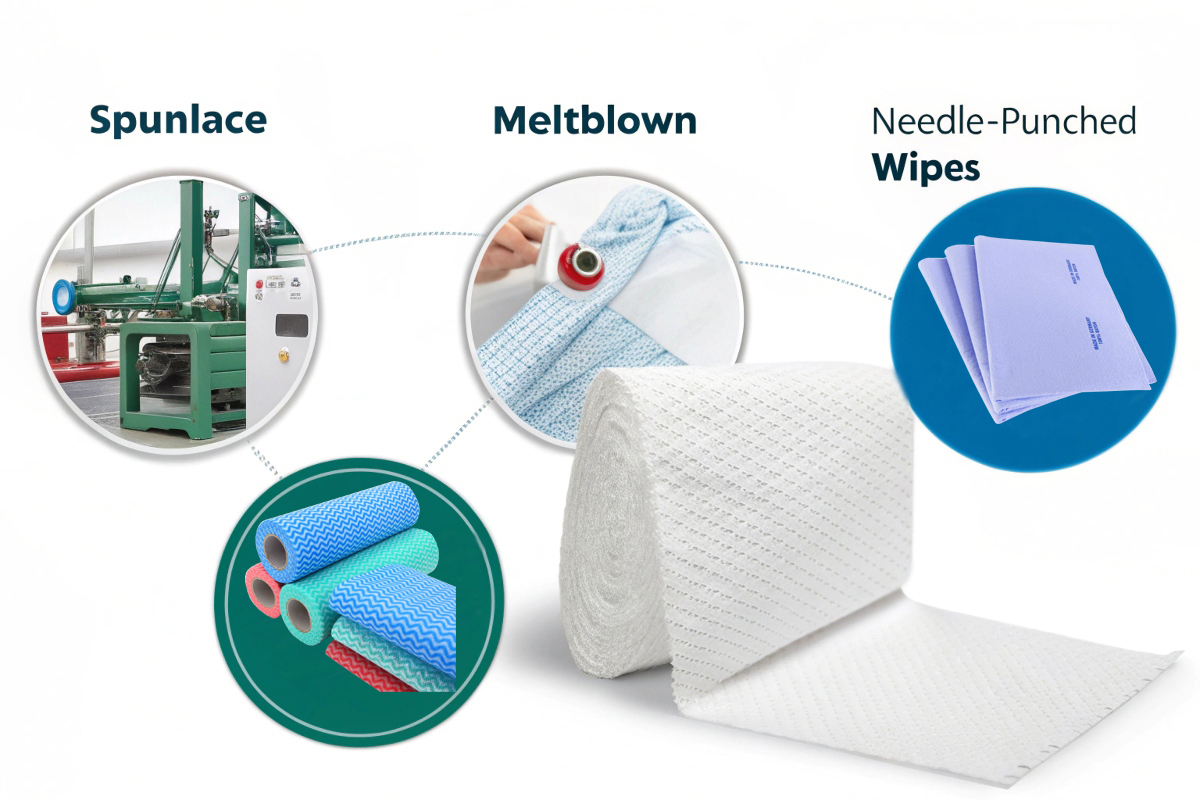
The core material used in wipes affects their performance, price, and regulatory classification. Here’s how they compare:
| Material | Absorbency | Durability | Chemical Resistance | Use Case |
|---|---|---|---|---|
| Spunlace | High | Medium | Medium | Household, Healthcare |
| Meltblown | Medium | Low | High | Automotive, Industry |
| Needle-punched | Low | High | High | Industrial cleaning |
Spunlace is water-jet entangled, offering softness and flexibility, ideal for baby or skin-contact products. Meltblown is fine-fibered and holds liquids well but lacks mechanical strength. Needle-punched10 fabrics are thick and abrasive, used for heavy-duty applications. Each material plays a specific role.
What About Packaging and Sizes?
Packaging isn’t just about looks—it’s about function and safety.
Household wipes come in small, resealable packs; industrial wipes need sturdy packaging like bulk pails or center-feed rolls for efficiency and hygiene.
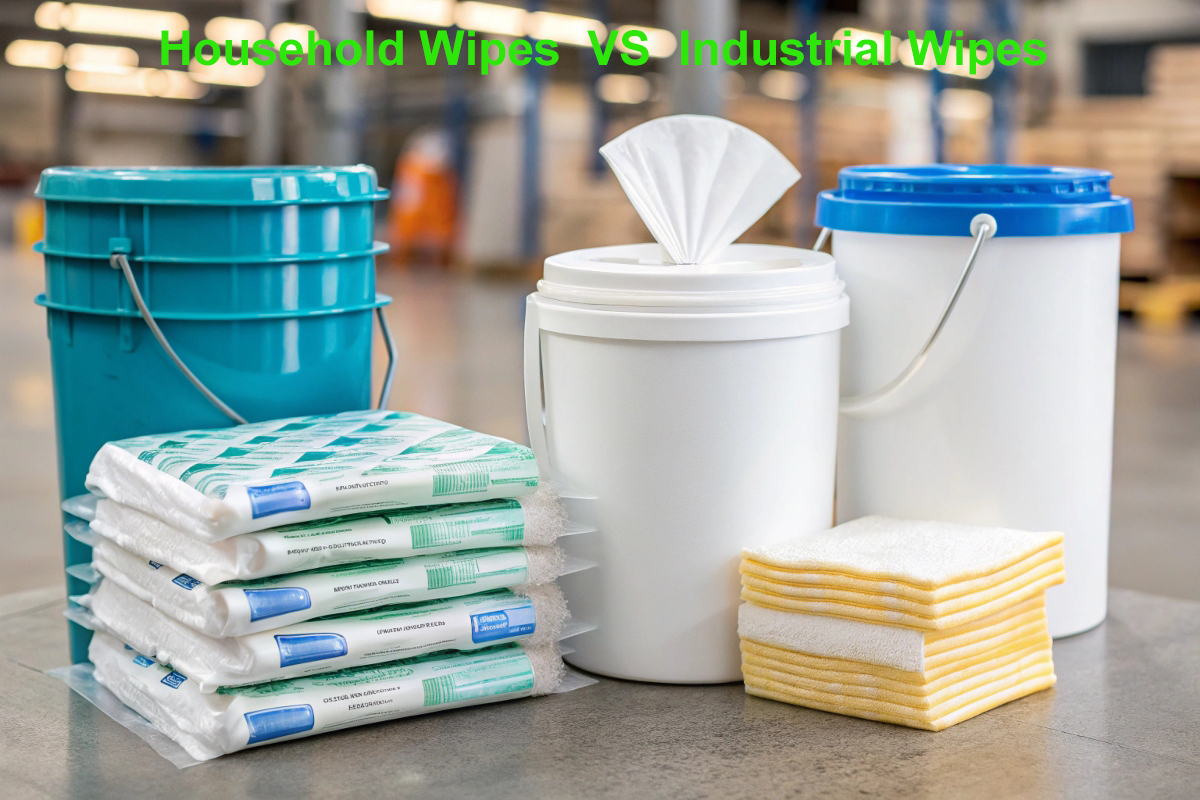
Different environments require different packaging. In households, users expect small packs they can open and reseal easily. Think about how a mother needs baby wipes in her bag or how a cleaner needs floor wipes under the sink.
Industrial settings, however, often use center-feed rolls for wall-mounted dispensers or large pails to avoid contamination. Here’s a comparison:
| Packaging Type | Common Use | Benefits |
|---|---|---|
| Resealable pouch | Household, baby care | Easy to store, lightweight |
| Plastic canister | Light industry | Better seal, stackable |
| Center-feed roll | Food & medical | One-hand dispensing |
| Bulk pails | Workshops | Durable, high volume |
The right packaging helps prevent drying, extends shelf life, and improves user efficiency.
Are the Ingredients and Certifications Different?
Consumers want comfort. Professionals need performance.
Household wipes use mild ingredients11; industrial ones include alcohols, quats, and solvents—often requiring EPA or REACH compliance12.
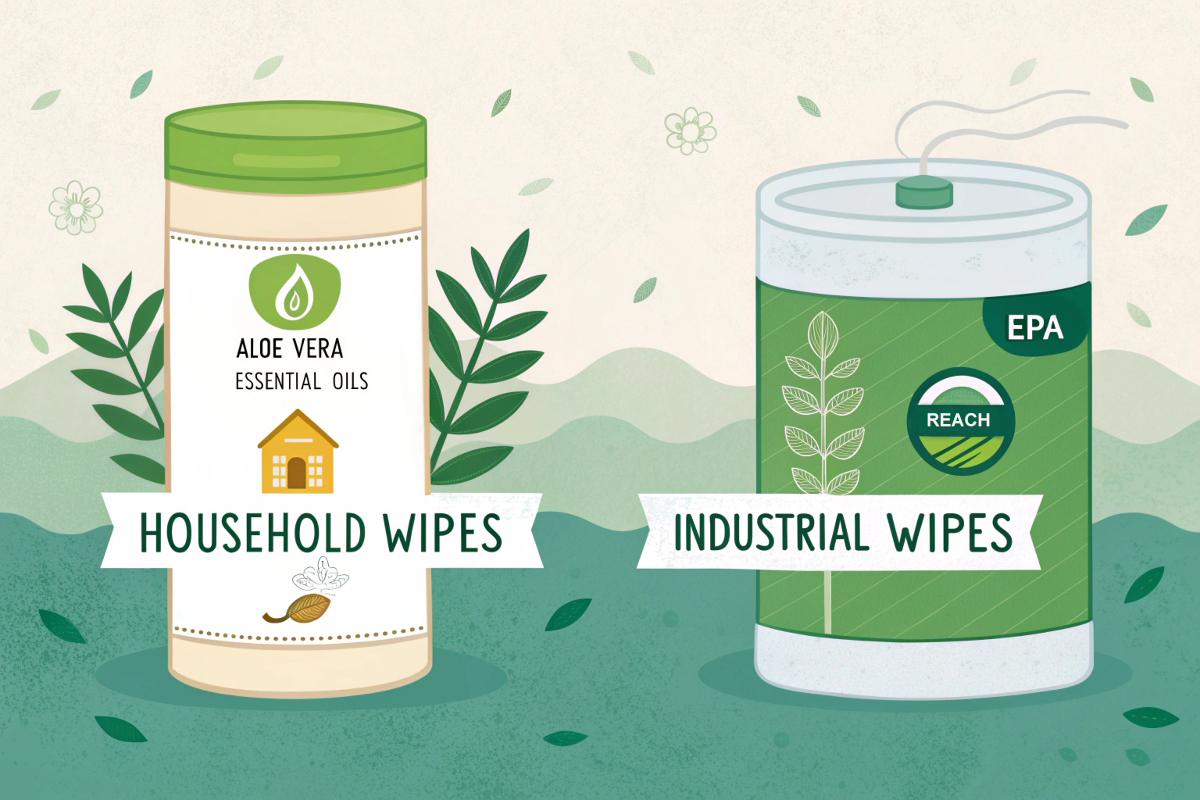
Active ingredients vary significantly. Household wipes often use water-based formulas with added glycerin, fragrance, or skin conditioners. Industrial wipes are all about performance—strong solvents, degreasers, or disinfectants.
Certifications also differ. Household wipes may need to pass skin irritation tests13. Industrial wipes may require:
- EPA registration14 (for disinfecting wipes in the U.S.)
- REACH compliance15 (EU chemical regulation)
- FDA clearance (for food-contact surfaces)
| Type | Common Actives | Certification Needed |
|---|---|---|
| Household | Surfactants, fragrance, aloe | Cosmetic safety tests |
| Industrial | IPA, ethanol, quats, solvents | EPA, FDA, REACH |
Always ask your supplier for relevant documents, especially when sourcing wipes for professional use.
Can They Be Used Interchangeably?
It’s tempting, but the wrong choice can be costly or dangerous.
Using industrial wipes at home or household wipes in factories can lead to damaged surfaces, ineffective cleaning, or even health hazards.
Industrial wipes often contain harsh solvents not meant for home surfaces like leather couches or baby skin. Likewise, using household wipes in a workshop won’t remove grease or disinfect bio-contaminated areas effectively.
I’ve seen customers try to save money by using cheaper household wipes for factory equipment, only to find residue buildup or poor sanitization. Some wipes also react badly with certain materials like rubber or aluminum.
Surface compatibility is a serious concern:
| Surface | Safe With Household? | Safe With Industrial? |
|---|---|---|
| Baby skin | ✅ | ❌ |
| Greasy engine | ❌ | ✅ |
| Kitchen table | ✅ | ⚠ (check ingredients) |
| Stainless steel | ✅ | ✅ |
When in doubt, ask your supplier for MSDS sheets16 or surface-compatibility reports.
What Are the Industry-Specific Uses?
Each sector has a unique need—and the right wipe for it.
From degreasing in auto shops to sanitizing in food factories, industrial wipes vary widely based on industry demands.
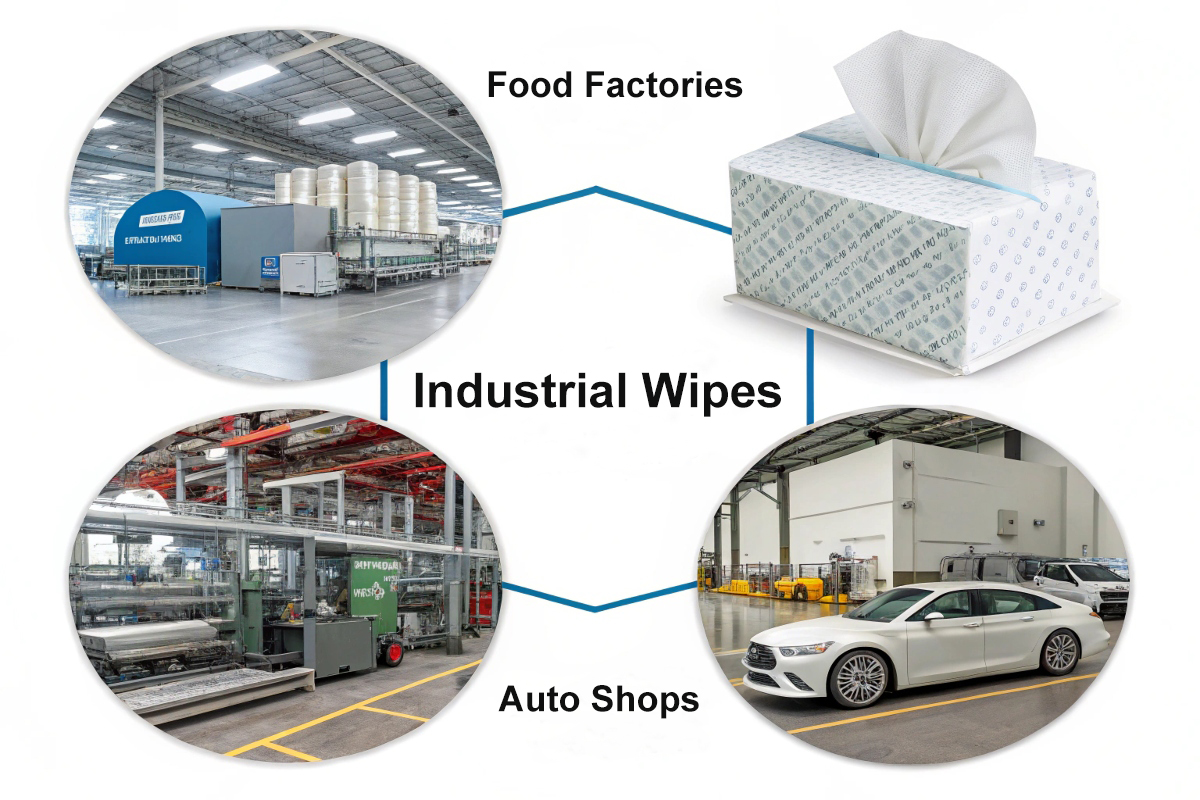
In my experience, customers in different industries ask for tailored wipes. Automotive workshops want tough degreasers with solvent resistance17. Food factories need wipes that clean without leaving residues. Healthcare customers require disinfecting wipes with proven pathogen kill rates.
Here’s how different industries match with wipe features:
| Industry | Wipe Type | Key Feature |
|---|---|---|
| Automotive | Solvent-infused | Heavy grease removal |
| Food Processing | Non-toxic disinfectant | No residue, food contact |
| Healthcare | Quat or alcohol-based | Disinfection, low lint |
| Manufacturing | Abrasive dry wipes | Dust removal, durability |
As a B2B buyer, always specify your industry use-case. A good manufacturer will offer samples with detailed test data.
What Should You Consider Before Buying?
A smart buyer looks beyond price.
Always consider pH, surface compatibility, chemical strength18, and shelf life when selecting wipes.
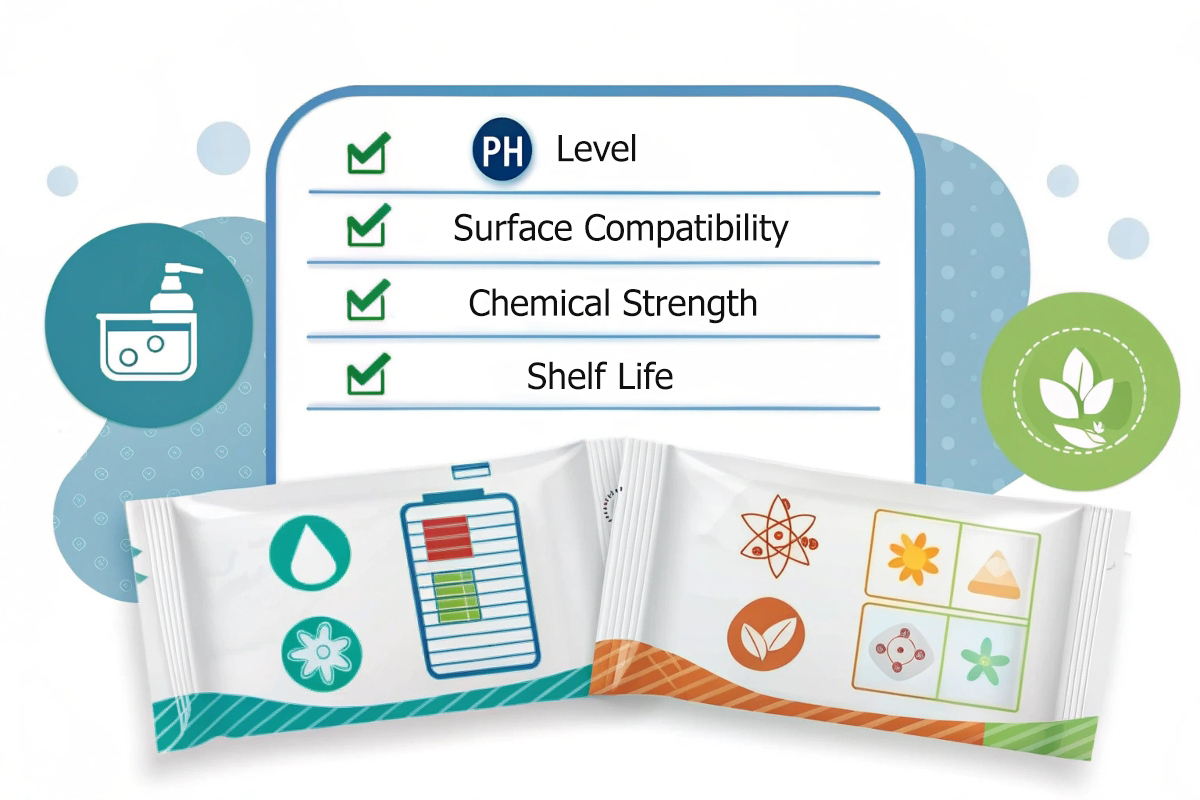
Before finalizing your order, run a checklist:
- pH level19: Neutral is safer for skin; alkaline is better for degreasing.
- Chemical compatibility: Check with your factory or home surfaces.
- Shelf life: Wet wipes can dry out; ask for storage recommendations.
- Certifications: Are they relevant to your region and application?
Also, ask about logistics. How quickly can the supplier deliver? Are there bulk discounts? Can they customize the formula or fragrance?
It’s always better to work with manufacturers like us who offer end-to-end solutions—including OEM/ODM20, R&D support, packaging customization, and quality tracking.
FAQs
Are industrial wipes antibacterial?
Yes, many are. Look for ones with alcohol or quats, and always check for EPA or EN test data.
Can household wipes be used in food service?
Only if labeled food-safe. Most household wipes contain fragrances or surfactants that are not approved for food contact.
Partnering With a Trusted Manufacturer?
Cutting corners on suppliers costs more in the long run.
Choosing a manufacturer with strong OEM/ODM capabilities ensures quality, compliance, and consistent supply.
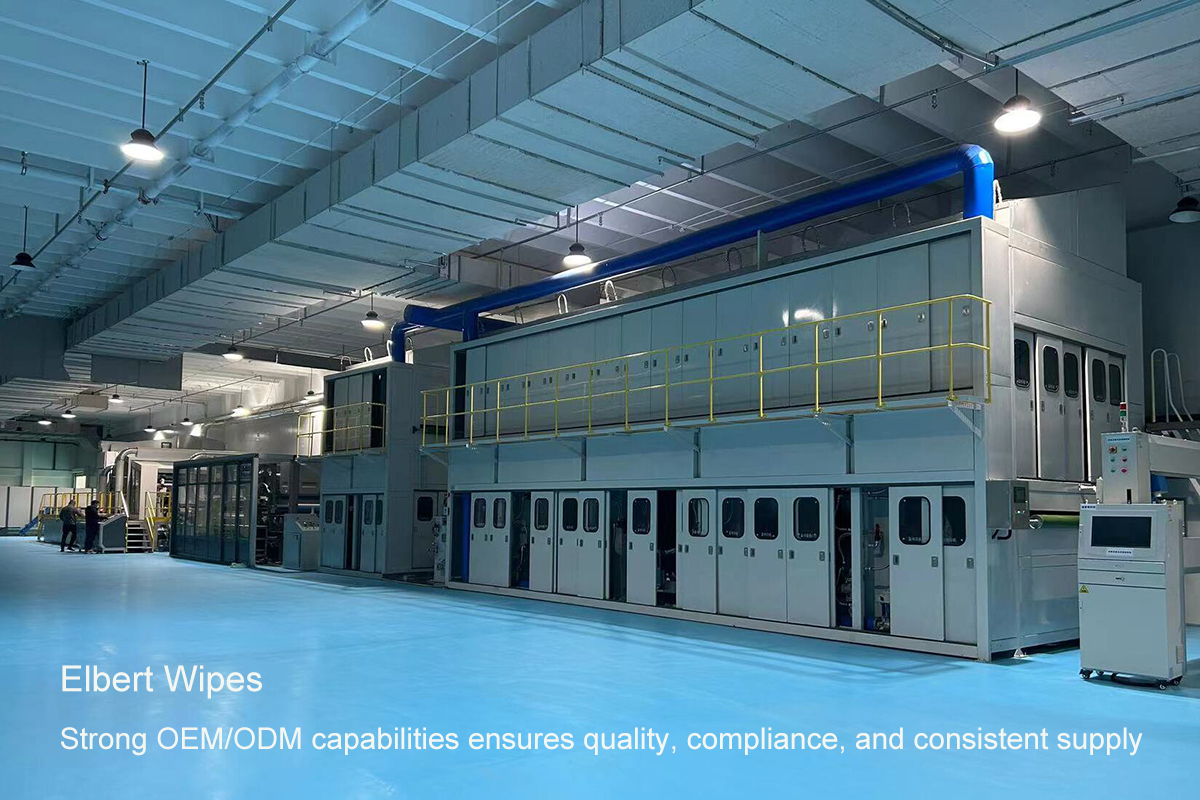
As someone in this industry, I’ve seen firsthand how working with the right supplier transforms a buyer’s experience. A good factory should offer more than just wipes—it should offer reliability, transparency, and flexibility.
Ask these questions before partnering:
- Can they show test reports and certifications21?
- Do they have clear QC and traceability processes?
- Can they adjust formulas or packaging to suit your market?
At ELBERT, we support OEM/ODM services22 with:
- 8 auto wet wipe lines
- 22 folding/rolling machines
- Over 10 types of eco-materials23
- Certifications like OEKO-TEX, BSCI, FSC
We serve global clients with fast lead times and competitive pricing, and we’re constantly innovating in both sustainability and performance.
Conclusion
Household and industrial wipes serve very different needs—understanding the differences helps you choose the right product every time.
Elbert Zhao
Founder, Elbert Wipes Solutions
📧[email protected] | 🌐 www.elbertwipes.com
8 production lines | 22 processing lines | OEKO-TEX certified | Walmart-approved supplier
-
Explore this link to discover the top-rated household wipes that ensure effective and safe cleaning for your surfaces. ↩
-
Find out more about light-duty cleaning techniques and the best products to use for maintaining your home or workspace. ↩
-
Learn about the various applications of industrial wipes and how they can effectively tackle tough cleaning jobs in different environments. ↩
-
Discover essential tips for keeping your kitchen clean and safe, enhancing your cooking experience. ↩
-
Learn how cleaning products affect safety and hygiene, ensuring a healthier living environment. ↩
-
Discover the properties of nonwoven fabric and why it’s commonly used in cleaning products for better performance. ↩
-
Explore the advantages of Meltblown material, known for its durability and absorption, crucial for effective industrial cleaning. ↩
-
Learn about Spunlace’s unique properties and its applications in various industries, enhancing your understanding of wipe performance. ↩
-
Discover the importance of biocides in healthcare wipes for effective disinfection and safety in medical environments. ↩
-
Discover the heavy-duty applications of Needle-punched fabrics and their effectiveness in industrial cleaning tasks. ↩
-
Discover why mild ingredients are essential for household wipes, ensuring safety and comfort for users. This resource will provide valuable insights. ↩
-
Understanding EPA and REACH compliance is crucial for ensuring safety and effectiveness in industrial wipes. Explore this link to learn more. ↩
-
Learning about skin irritation tests can help you choose safe household wipes that are gentle on the skin. ↩
-
Understanding EPA registration is crucial for ensuring the safety and effectiveness of disinfecting wipes used in various settings. ↩
-
Exploring REACH compliance helps you understand the regulations that ensure chemical safety in products like industrial wipes. ↩
-
Discover how MSDS sheets can guide you in choosing the right cleaning products for safety and effectiveness. ↩
-
Understanding solvent resistance helps ensure you choose the right wipes for tough cleaning tasks, especially in automotive settings. ↩
-
Learning about chemical strength can guide you in selecting wipes that effectively tackle specific cleaning challenges in various industries. ↩
-
Understanding pH levels in cleaning products can help you choose safer options for your skin and surfaces. Explore this resource for detailed insights. ↩
-
Discover how partnering with OEM/ODM manufacturers can enhance product quality and compliance, ensuring a reliable supply chain. ↩
-
Learn why certifications and test reports are crucial for ensuring product quality and compliance in the manufacturing industry. ↩
-
Explore this link to understand how OEM/ODM services can enhance your product offerings and supplier relationships. ↩
-
Discover the benefits of eco-materials in manufacturing and how they contribute to sustainability in your products. ↩

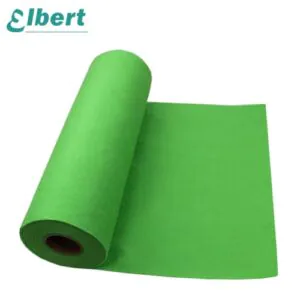


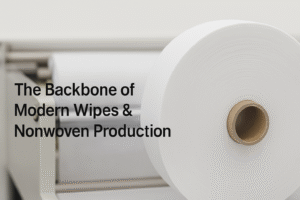

14 Responses
Если нужен удалённый сервер, можно воспользоваться vps xrumer, что обеспечит бесперебойную работу.
Большое спасибо за советы.
Особенно удобно, что кредит онлайн на карту CreditKasa https://creditka.org.ua/ru/creditkasa доступен без звонков и визитов в офис. Полностью онлайн и быстро.
Спасибо
Узнайте подробности касательно цифровых валютах и площадках для обмена в этом ресурсездесь. Экспекты по анализу обменника.
Thanks
https://ukrbeautystyle.com.ua/product/Kofta-Tommy-Hilfiger-zhnocha-kolr-sinj-z-aplkatsjuhttps://ukrbeautystyle.com.ua/product/Dzhinsi-Tommy-Jeans-zhnoch-visoka-posadka-1https://ukrbeautystyle.com.ua/product/Bavovnjana-futbolka-Tommy-Hilfiger-zhnocha-kolr-chornij-WW0WW43459https://ukrbeautystyle.com.ua/product/Bavovnjana-futbolka-Marc-OPolo-kolr-sinj-odnotonnijhttps://ukrbeautystyle.com.ua/product/Kofta-Guess-CARLA-zhnocha-kolr-korichnevij-z-kapjushonom-z-aplkatsju-V4YQ11-KB3P2https://ukrbeautystyle.com.ua/product/Tommy-Jeans-Sorochka-1https://ukrbeautystyle.com.ua/product/Tommy-Jeans-Futbolka-4https://ukrbeautystyle.com.ua/product/Bjustgalter-Calvin-Klein-Underwear-kolr-zhovtij-odnotonnijhttps://ukrbeautystyle.com.ua/product/Sorochka-Tommy-Jeans-cholovcha-kolr-blij-slim-klasichnij-komr-DM0DM04405https://ukrbeautystyle.com.ua/product/Kurtka-Tommy-Hilfiger-zhnocha-kolr-sinj-perehdna-WW0WW42046https://ukrbeautystyle.com.ua/product/Tommy-Jeans-Futbolka-5https://ukrbeautystyle.com.ua/product/Bavovnjana-futbolka-Marc-OPolo-kolr-chornij-z-printomhttps://ukrbeautystyle.com.ua/product/Shkrjanij-remn-Tommy-Hilfiger-cholovchij-kolr-sinj-AM0AM08363https://ukrbeautystyle.com.ua/product/Bavovnjana-futbolka-Marc-OPolo-kolr-blij-z-printomhttps://ukrbeautystyle.com.ua/product/Bjustgalter-Calvin-Klein-Underwear-kolr-chornij-merezhivo-odnotonnij-3https://ukrbeautystyle.com.ua/product/Bjustgalter-Calvin-Klein-Underwear-kolr-chornij-odnotonnij-10https://ukrbeautystyle.com.ua/product/Shkrjanij-remn-Tommy-Hilfiger-cholovchij-kolr-chornij-AM0AM08360https://ukrbeautystyle.com.ua/product/Tommy-Hilfiger-Futbolka-2https://ukrbeautystyle.com.ua/product/Bluzka-Hoss-Intropia-zhnocha-kolr-foletovij-vzerunok-5878038https://ukrbeautystyle.com.ua/product/Shkrjan-baletki-Vagabond-Shoemakers-HERMINE-kolr-bordovij-5733-018-47
Thanks for your attention!
The popularity of webcamsex xxxbabes4u.com is growing fast because it feels spontaneous and authentic. Users like the ability to choose performers instantly.
Many people choose to get medicine online from registered pharmacies. This ensures authenticity and safety.
Travelers arriving late at night often find Thessaloniki airport car rental thessalonikicar-rental.com the most convenient option. It saves time and allows you to head directly to your hotel.
awesome
Hello !!
I came across a 137 great tool that I think you should explore.
This platform is packed with a lot of useful information that you might find valuable.
It has everything you could possibly need, so be sure to give it a visit!
[url=https://www.sdasrinagar.com/bicycle-myths-that-are-not-true/]https://www.sdasrinagar.com/bicycle-myths-that-are-not-true/[/url]
And remember not to overlook, folks, which you constantly can inside this particular article find solutions to address the most complicated inquiries. Our team attempted to lay out all of the information in the extremely easy-to-grasp way.
Thanks!